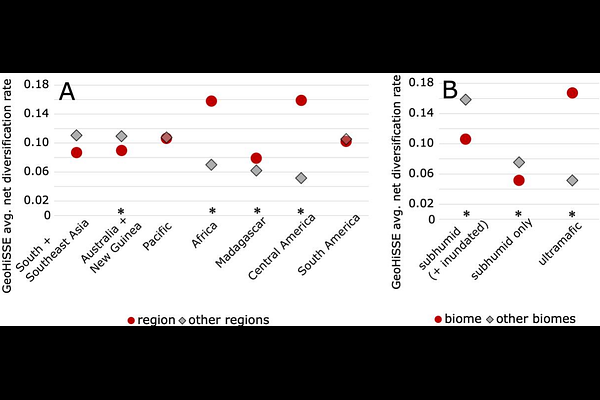Synchronous Miocene radiations and geographic-dependent diversification of pantropical Xylopia (Annonaceae)

Synchronous Miocene radiations and geographic-dependent diversification of pantropical Xylopia (Annonaceae)
Nge, F. J.; Johnson, D. M.; Murray, N. A.; Holzmeyer, L.; Floyd, K.; Stull, G.; Soule, V.; Sepulchre, P.; Tardif, D.; Rodrigues Vaz, C.
AbstractAim: The evolutionary drivers of hyperdiversity in tropical rain forests are complex and multifaceted. We used the pantropical Xylopia (Annonaceae) genus to address the diversification of rain forest lineages through time, across different regions, and into novel non-rain forest habitats with a comparative phylogenetic approach. Location: Global (pantropical) Methods: We generated a time-calibrated phylogeny of Xylopia using hybrid capture sequence data, including 88% (168/191 spp.) of species within the genus. Diversification analyses were conducted to test for the presence of rate heterogeneity (BAMM, ClaDS, CoMET) and environmental-dependent (RPANDA), geographic-dependent, and habitat dependent (GeoHiSSE) diversification in Xylopia. Results: Significant diversification rate heterogeneity was detected along the backbone of the core Xylopia clade, leading to near synchronous radiations across tropical regions globally in the Miocene, with higher diversification rates in Africa, Central America, and Madagascar, and lower rates in Australia + New Guinea. Transitions from rain forest to subhumid habitats led to lower diversification rates, whereas transitions to ultramafic habitats lead to higher rates. Regional diversification models indicate sea-level changes as an important driver for Asian, Australian, Pacific, and Neotropical clades and regional temperature changes as the main diversification driver for an African clade of Xylopia. Main conclusions: Our study shows that despite synchronous radiations across regions, different regional environmental drivers have affected the diversification of Xylopia across tropical regions globally. A noteworthy example includes radiations of all five Malagasy clades c. 7 Ma coinciding with the establishment of heavy seasonal rainfall linked with the Indian monsoon. The diversification dynamics of rain forests are complex and heterogenous, with different clade-dependent and region-dependent environmental drivers.